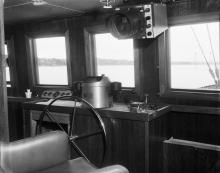Navigation: the 20th Century to the Present
The nineteenth century was the century of longitudeLongitude
Longitude lines around the globe run north-south, and measure position east or west of a reference line.
Read More, factory-produced high quality instruments, chartingChart
A nautical map giving navigation information, including: water depth; shoals, rocks, and other dangers; and aids to navigation such as lighthouses, buoys, and beacons. Charts use special symbols and abbreviations to convey information for mariners., and oceanography. The twentieth was the age of electronic navigationElectronic navigation
Using electronic means and satellites to find your location or the location of other objects at sea., which has made celestial navigationCelestial navigation
Using the sun, moon, stars, and planets to find your location. almost obsolete.
Radio was developed in the early 1900s. By the mid 20th century, radio direction finding using beacons was common. Using the science of the 1920s, developments during World War II in sonarSonar
Derived from Sound Navigation and Ranging Device.
Read More and radarRadar
Stands for "radio detection and ranging." Radar was developed in World War II
Read More made these available to large vessels and then to anyone, in the late 20th century, due to electronic miniaturization. A mid-nineteenth century concept, not practicable until the twentieth, was the gyroscopic compassGyroscopic compass gyro compass, gyrocompass
An instrument receiving its directive force from a gyroscope operated by electric motors. Its directive action is based on the mechanical laws governing the dynamics of rotating bodies.
Read More. It holds its position relative to the rotation of the earth, when the flywheel is kept spinning. The availability of shipboard electricity let Elmer A. SperrySperry, Elmer A. Elmer A. Sperry
1860-1930. American engineer and inventor best known for his work on the gyrocompass. In 1908 he patented the gyrocompass and in 1910 set up the Sperry Gyroscope Company to build it.
Read More devise a gyroscope in 1911 that showed true northTrue North
The direction of the North Pole from any place on the earth's surface, through which all meridians of longitude pass on maps and charts.
Read More. It was particularly valuable as magnetic compasses proved less reliable on board steel ships. After World War I, gyro compasses became standard on large naval and merchant ships.
Electronic position finding, or loranLORAN
A system of long-range navigation invented during World War II, in which pulsed signals sent out by 2 pairs of radio stations are used to determine the geographical position of a ship or airplane. It is maintained today as a backup to GPS., used beacons to fixFix
The determination of a ship's position by celestial observations or by terrestrial observation of landmarks or aids to navigation, or some combination of each. The term is used only when the position is not subject to doubt. positions. Developed during World War II, it is a system that uses master and slave transmitters and calculates position based on the time between the signals arriving at the ship. This system and others like it had to be used near land.
Today’s Global Positioning SystemGlobal Positioning System GPS
Satellite-based navigation system developed and operated by the United States Department of Defense becoming operational in 1993. It uses 24 satellites, and users can determine position, speed and time. has made other electronic systems obsolete. It is based on the Doppler effectDoppler effect
The apparent change in frequency and wavelength of a wave moving relative to the source of the waves. It can result from the motion of the observer or the motion of the source. These frequency changes can be measured and distances calculated. of radio signals sent from two or more satellites. Its accuracy and reliability has made celestial navigation no longer a required skill for merchant or naval officers.
Guides for Navigators
With the availability of GPS and computers, most charts are now available in digital form. They can be read on electronic chart plotters or on laptop computers, and when connected to a GPS and radar, the screen can tell the navigator most of the information needed for safe navigation. For those who want to use paper charts for pilotingPiloting pilotage
The art of navigating along coasts, using visual guides., charts are now available either in single sheet form or as books of many charts not unlike the nautical atlases of the seventeenth century.
Updates of chart information, weather and tide information, and other useful navigational data are available now on the World Wide Web; a satellite telephone lets a ship at sea connect.

